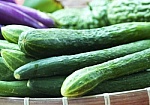Winter Vegetables Growing Basics for the Beginner
 Growing vegetables inside the winter is actually a matter of harvesting, not a lot growing. The concept is to get the vegetables rising throughout the late summer and then harvest them throughout the winter by guarding them from exposure towards the components and denying them water. Water in the plant cells is what freezes and kills the plants, so watering ought to quit as frost starts to set in.
Growing vegetables inside the winter is actually a matter of harvesting, not a lot growing. The concept is to get the vegetables rising throughout the late summer and then harvest them throughout the winter by guarding them from exposure towards the components and denying them water. Water in the plant cells is what freezes and kills the plants, so watering ought to quit as frost starts to set in.
It’s necessary to decide on cold hardy vegetables — consider kohlrabi, broccoli and cabbage — the cruciferous vegetables. You can’t grow or harvest summer time vegetables like cucumbers, tomatoes, peppers and squash through the winter.
Winter Vegetables
A few of the most cold hardy vegetables are leek and kale. Several of the Asian greens like Bok Choi are also cold hardy.
Leek is really a plant typically used in soups and stews, and may be substituted for onion in several recipes. This sort of plant presents us the stalk for consumption. The white lower portion in the stalk is often sliced across for great “rounds” in a soup or it may be utilized substantially like an onion in stir fried vegetables and also the like. Leeks can “winter over” in increasing zones 4 and increased if offered some protection.
Kale is often a green, much like Swiss chard, mustard or turnip greens. We consume the leaves from the plant. It can be used in soups, stews and prepared as a steamed green by itself. It’s very cold hardy and can withstand frost and winter climate with small or no protection in zones six and greater. Offered somewhat protection, Kale will survive in zones four throughout the winter.
I’ve harvested Bok Choi from my unheated greenhouse after minus 14 F. Lettuce can quickly go below freezing, and radishes, turnips, peas, broccoli, Brussels sprouts and cabbage are also extremely cold tolerant.
Protection Through the Winter
The fundamental resources essential to protect vegetables from winter weather are row covers, garden tunnels, unheated greenhouses and cloches. Several can be made from straightforward supplies.
In milder climates, a single cover is all that’s necessary. In colder climates like zones 4 and reduce, a double cover is called for. A cold frame with an added clear plastic cover works quite effectively, but a hoop house or greenhouse type structure provides you with much more room to work, and it keeps you out from the winter weather as well.
The clear plastic covering of a garden structure protects plants from the harsh winter winds, and will allow for the capture of sunlight to help heat the area where the plants are increasing. Don’t use raised beds through the winter as they’re going to quit their heat to the surrounding place really quickly.
Cold climate rising and harvesting of vegetables need to be done at ground level, so the all-natural heat from the earth is going to be trapped by the layers of clear covering. That’s a single purpose why root crops and other close towards the ground vegetables are the finest choice for winter gardening – they can simply be covered using a row cover or cold frame.
Assume of each layer of plastic as a blanket. For cold weather use one blanket, for very cold weather use two.
Harvesting
Most of what you happen to be going to perform in the winter is harvest. Planting and increasing are for probably the most component out in the question. You must save that for spring.
Provided that you have not watered your plants through the winter, they should be in somewhat decent form for harvesting. The important thing is to enable them to warm up a bit just before harvesting. Let them get well above freezing for a minimum of a few hours ahead of you try to harvest.
This might mean waiting each day or so in between harvests, but when you do not wait till it warms up under these “blankets,” you will be harvesting mush. Let the sun do its task and warm factors up to get a couple of hours just before you begin gathering your crispy crops from that life-size refrigerator.
Recent Comments